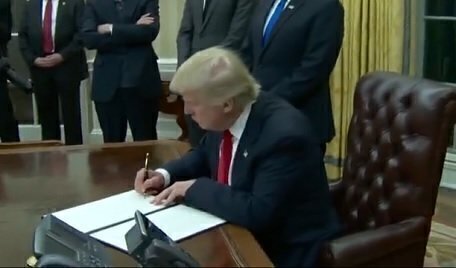 In the first 10 days of Donald Trump’s presidency, controversy shrouded the administration. Perhaps nothing drew more opposition and backlash, including from some Republicans, as Executive Order 13769.
In the first 10 days of Donald Trump’s presidency, controversy shrouded the administration. Perhaps nothing drew more opposition and backlash, including from some Republicans, as Executive Order 13769.
The order, entitled “Protecting the Nation from Foreign Terrorist Entry into the United States,” sparked protests at airports in major cities across the country as individuals from seven predominately Muslim nations were held at airports or sent back to their country of origin. Within hours of the order, a federal court in Brooklyn granted an “emergency stay,” and a few days later, acting Attorney General Sally Yates was fired from her position for “refusing to enforce a legal order designated to protect the citizens of the United States.”
Executive Order 13769 is one of seven executive orders issued by the Trump administration in its first 10 days. That is the same amount that John Adams, Thomas Jefferson, James Madison and James Monroe issued during their entire presidencies—combined.
For almost a century after the founding of the United States, the amount of “executive orders” was relatively limited. That may be because there is no actual provision in the Constitution that speaks to executive orders. The power has developed over time, with presidents using Article II, Section 3—the “Executive” should “take Care that the Laws be faithfully executed”—as a basis for creating law without Congress as long as it holds true to the Constitution.
Perhaps the most famous executive order, the Emancipation Proclamation signed by President Abraham Lincoln, marked a shift in the power of the executive branch to essentially circumnavigate Congress when deemed necessary. During Lincoln’s four years as President, he signed 48 executive orders, the most of any President until that point. However, the deteriorating state of the nation and the urgency of action on both practical and moral levels could justify what many believe was an increase to the power of the executive branch.
While the average number of orders increased in the latter part of the 19th century, three men in the 20th century truly expanded the power of the executive via the executive order: Theodore Roosevelt with a total of 1,081 orders, Woodrow Wilson with 1,803 and Franklin D, Roosevelt with a lofty 3,522 total executive orders. The federal government, the executive branch and much of the security apparatus as we know them today are results of these presidents and the actions they took.
Since Eisenhower took office in 1953, no modern president has come close to the number of orders of even Theodore Roosevelt. Ronald Reagan had 381 over his 8 years, George W. Bush had 291 and Barack Obama had a total of 276. But are these numbers still far too high?
The debate over the power of the executive branch is as old as the country itself. Even with the comparably low number of executive orders by today’s standards, Lincoln’s adversaries called him “King Lincoln.” President Obama faced similar criticism by Republicans throughout his presidency.
While Obama was slightly below average for the number of executive orders issued during his presidency, he did sign nine orders in his first 10 days. The only other modern president to come close to that amount of action right out of the gate is President Trump.
Within the first 10 days of his presidency, Trump has attempted to fulfill some of his central campaign promises through executive order, including first steps to repeal the Affordable Care Act, the early stages of building a wall and securing the border between the United States and Mexico, and banning immigration from seven nations, including refugees from war-torn Syria, in defense of national security.
Adversaries of specific executive orders are often the opponents of the party in power. For example, many liberals that are opposed to Trump’s order to move forward with building the Dakoda Access Pipeline were pleased when the Obama administration took steps to stop its construction. In addition, the constitutionality of the law outlined in the orders themselves is a major factor of whether the public and, more importantly, the courts may approve.
However, there is also a more fundamental question: Should executive orders be considered constitutional in the first place? Do they give too much power to one branch of government and therefore obscure the system of checks and balances intended by the Framers of the Constitution?
Presidents have used executive orders to advance civil rights, as President Harry Truman did with Executive Order 9981, which abolished racial discrimination in the United States Armed Forces, or as Lyndon B. Johnson did with Executive Order 11246, which prohibited “federal contractors and federally assisted construction contractors … from discriminating in employment decisions on the basis of race, color, religion, sex, or national origin." Yet it was also through an executive order that FDR created Japanese internment camps during World War II.
The Trump administration will surely face tough legal and political battles concerning the way he wields his executive power, just as many presidents have before him. While many of Trump’s executive orders will likely face the scrutiny of the courts, and while the wisdom and morality of his action will be judged by the public, it is evident from Trump’s first 10 days that the power of the executive is not shrinking any time soon.
Maggie Baldridge is an intern at the National Constitution Center. She is also a recent graduate of Dickinson College.







